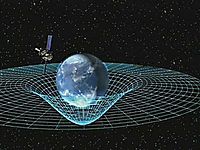
Photo from wikipedia
A general quantum-mechanical formalism is reviewed for double electron capture from heliumlike atomic systems by fast nuclei. The development is carried out with and without the distorted wave theory by… Click to show full abstract
A general quantum-mechanical formalism is reviewed for double electron capture from heliumlike atomic systems by fast nuclei. The development is carried out with and without the distorted wave theory by fulfilling the correct boundary conditions. These refer to the required asymptotic behaviors of the total scattering wave functions and their appropriate connections to the perturbation interactions that produce the transitions from the initial to the final states of the system. In this general formulation any choice is allowed for the pairs of the distorting potentials and the related distorted wave functions as long as the correct boundary conditions are satisfied. This is the case with the four-body versions of several most frequently used methods (continuum distorted wave: CDW-4B, boundary-corrected continuum intermediate state: BCIS-4B, Born distorted wave: BDW-4B, continuum distorted wave initial/final state: CDW-EIS/EFS-4B, and the boundary-corrected first Born: CB1-4B). A comparative analysis of these methods makes in evidence both their similarities and differences. For example, the most illustrative is the juxtaposition of the post BDW-4B and CDW-EIS-4B methods. They share the same distorting potential in the exit channel. The only difference is in the coordinates from the Coulomb logarithmic phases in the initial distorted wave functions. This difference is completely negligible in the asymptotic scattering regions. Yet, for e.g. double electron capture from helium by alpha particles, the total cross sections from these two methods differ by 1–3 orders of magnitudes. The BDW-4B method is in agreement with experimental data at high impact energies. In sharp contrast, within its validity domain of impact energies, the CDW-EIS-4B method underestimates the measured data by orders of magnitude. This shows that what matters is not solely the correct asymptotes of distorted wave functions, but rather how they affect the contributions to the integrals over the entire regions in the T-matrix elements for total cross sections. Such insights help understand the assessment of the overall validity and relative performance of various methods, and can provide a versatile guidance for improving the existing approximations for double charge exchange in fast ion–atom collisions.
Journal Title: Journal of Mathematical Chemistry
Year Published: 2018
Link to full text (if available)
Share on Social Media: Sign Up to like & get
recommendations!